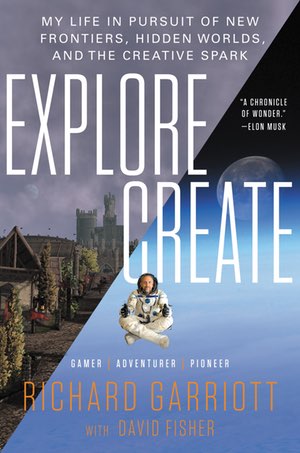Review: Explore/Createby Jeff Foust
|
| While best known for flying on a Soyuz to the International Space Station in 2008, he had been trying to find a non-NASA way into space for two decades. |
Explore/Create, the new memoir by Richard Garriott, the computer gaming pioneer and private spaceflight participant, has one of the more eclectic, but also A-list, group of people offering their endorsements for a book. There’s former Soviet astronaut Alexei Leonov, who calls Garriott “a great example of the second generation of space explorers” (Garriott’s father was a NASA astronaut.) There’s also Steve Wozniak, the cofounder of Apple, who describes how he was “nearly speechless” the first time he met Garriott. Stephen Hawking—yes, that Stephen Hawking—mentions taking a zero-g aircraft flight with Garriott. And Elon Musk compares his space ambitions with Garriott’s and says, “Perhaps one day our kids will create and play games on a new world!”
That range of endorsers reflects the varied life that Garriott recounts in the book. Growing up in Houston, he thought it was obvious that one day he would go into space himself. But he was told at age 13 his eyesight was too poor to qualify as a NASA astronaut. His dreams of spaceflight put on the back burner—but not forgotten—he soon rose to prominence as an early computer game developer, best known for the Ultima series. Much of the book delves into the accomplishments and challenges he faced in that career.
Garriott returns to the topic of space later in the book. While best known for flying on a Soyuz to the International Space Station in 2008, he had been trying to find a non-NASA way into space for two decades. In the book, he describes how he and his father established a company called Extended Flights for Research and Development, or EFFORT, around 1987 to develop a pallet for the shuttle’s cargo bay that would allow the shuttle to remain in orbit for more than a month. NASA was not interested. He was an early investor in Spacehab, the company that developed pressured modules for the shuttle with visions, ultimately unrealized, of some day carrying people commercially.
Garriott was also an early investor in space tourism company Space Adventures, and funded out of his own pocket a $300,000 study by the Russian space agency Roscosmos to determine if it was feasible for private citizens to fly on Soyuz spacecraft. When the answer came back in the affirmative, “I immediately booked my flight,” he wrote. However, the dot-com crash wiped out much of his net worth, including the money he planned to use for the flight. Dennis Tito instead got to fly in the seat Garriott planned to buy.
Garriott rebuilt his wealth and got another opportunity to fly in 2008. By that time Tito and other had blazed the trail for spaceflight participants—aka space tourists—flying to the ISS on Soyuz vehicles, and Garriott writes that the professional astronauts he trained with “never made me feel like an interloper.” However, he recalls how, 72 hours before launch, “NASA made a final effort to stop me” by requesting changes to his Space Act Agreement that would have prohibited him from doing experiments in or even entering the US segment of the station. The reason for the change was never made clear, but Garriott signed it on the condition that the agreement restated the station commander’s authority to modify rules while in orbit. Once he got to the station, the commander, Mike Fincke, told him to do his work where he originally planned, effectively negating those changes.
| “I think I’ll get a chance to go back many times, and many people in this room who also wish to go will be able to do so,” he said in a speech last year. |
At the end of the book, he says that his wife has forbidden him from flying in space again because of his responsibilities as a husband and father. “I do want to go back one day, and I suspect she may change her mind about it,” he writes. (His wife, Laetitia, was a co-founder of a company, Escape Dynamics, that studied advanced propulsion technologies that could greatly lower launch costs, but shut down when it could not raise the money needed to further develop that technology.)
Garriott sounded a similar optimistic tone in a talk in October at the Explorers Club in New York. “I think I’ll get a chance to go back many times, and many people in this room who also wish to go will be able to do so,” he said. That’s predicated not on advanced propulsion technologies but instead efforts by companies like SpaceX to lower the cost of launch.
“Elon has said to me personally that he can get the price [per person] down to under $1 million,” he said in the talk, which he said allows the business case for commercial human orbital spaceflight to close. “If I can go for $1 million, I can make money flying to space. And if I can do it, I’m sure there’s others of you here who can.”
Explore/Create is an entertaining book that describes Garriott’s twin passions to explore (not just space but also the deep sea and Antarctica, among other places) and create. Space is just a small part of his story, and this book, which puts his pursuit of spaceflight into a broader context. If he does get to fly again in space, it’s clear that he’ll find something to do in orbit that no one has done before.
